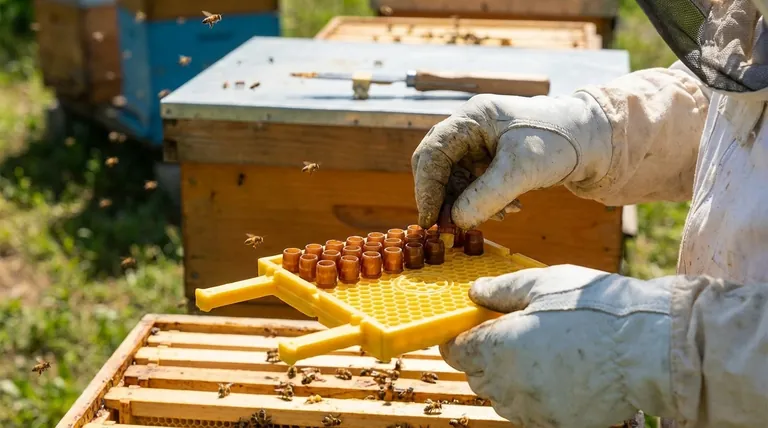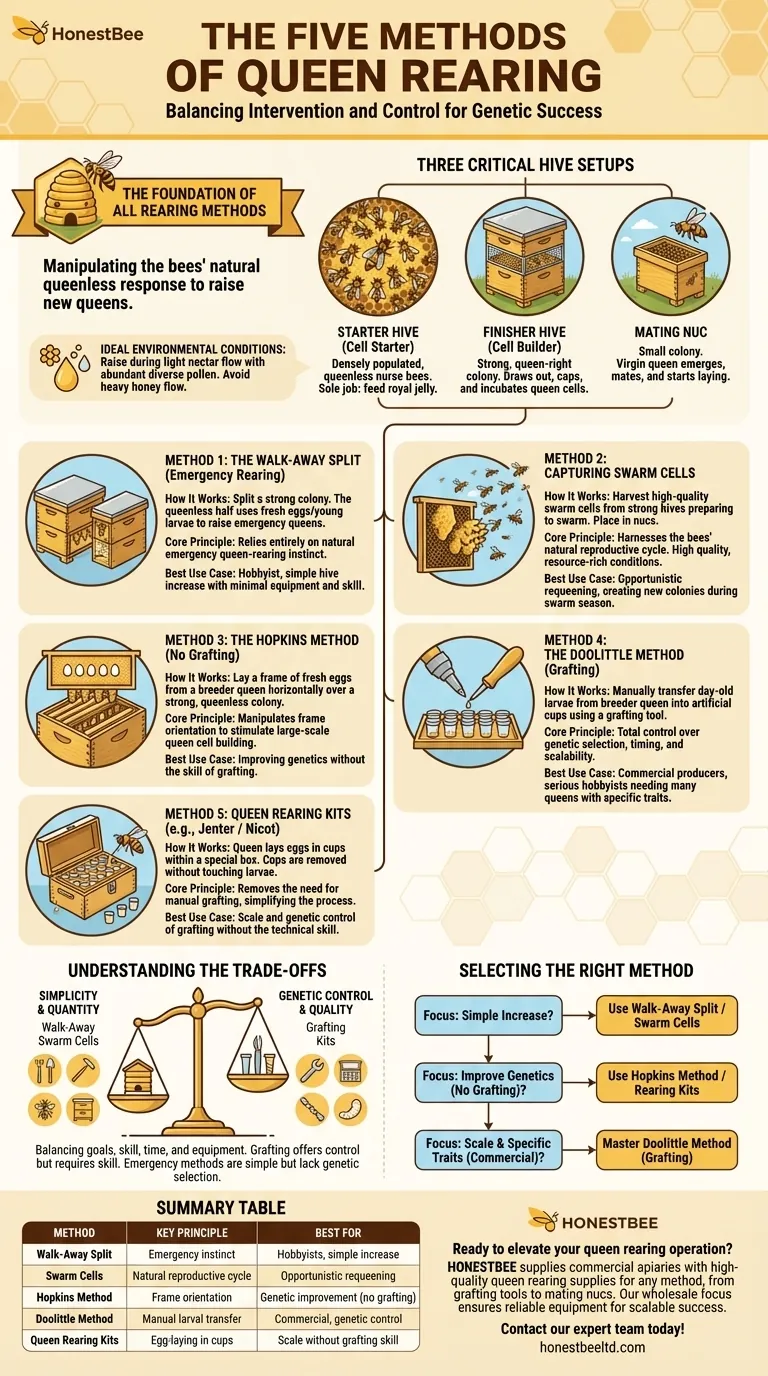There is no single, universally agreed-upon list, but queen rearing techniques are best understood by their level of intervention, ranging from simple splits to highly controlled commercial methods. The five most common and distinct approaches are the Walk-Away Split, using swarm cells, the Hopkins Method, the Doolittle Method (grafting), and modern cell cup kits like the Jenter system.
The core of all queen rearing is creating a controlled "emergency" in a hive. Your choice of method simply dictates how much control you exert over the process, balancing simplicity against the ability to select for specific genetic traits and produce queens at scale.

The Foundation of All Rearing Methods
Before examining specific techniques, it's crucial to understand the universal principles that enable them. All methods manipulate the bees' natural instinct to raise a new queen when they perceive they are queenless.
The Three Critical Hive Setups
Regardless of your chosen method, the process typically involves specialized colonies. As noted in beekeeping literature, these are the starter hive, the cell builder (or finisher) hive, and the mating nuc.
The starter is a densely populated, queenless colony overflowing with nurse bees, whose sole job is to feed royal jelly to the young larvae in the queen cells you've introduced.
The finisher is a strong, queen-right colony (with the queen separated by an excluder) that will draw out, cap, and incubate the developing queen cells.
Finally, each mature queen cell is moved to a small mating nucleus colony (nuc), where the virgin queen emerges, hardens, takes her mating flights, and begins to lay.
Ideal Environmental Conditions
Success in queen rearing is highly dependent on the environment. You should aim to raise queens during a light nectar flow with an abundance of diverse pollen.
A heavy honey flow can distract the bees, causing them to prioritize nectar storage over the intensive labor of feeding and caring for new queens.
Method 1: The Walk-Away Split (Emergency Rearing)
This is the simplest, most hands-off method of creating a new queen and colony.
How It Works
You simply split a strong colony into two, ensuring the half without the original queen has frames with fresh eggs and very young larvae. The bees in the queenless half will recognize their status and initiate the emergency response, selecting several larvae to raise as new queens.
Core Principle
This method relies entirely on the bees' natural emergency queen-rearing instinct. You provide the necessary resources (eggs, nurse bees, food) and let the colony handle the rest.
Best Use Case
This is ideal for a hobbyist who wants to increase their hive count with minimal equipment and technical skill. It requires no special tools or delicate procedures.
Method 2: Capturing Swarm Cells
This method is opportunistic, leveraging the bees' natural impulse to reproduce via swarming.
How It Works
During swarm season, you can find queen cells in strong hives preparing to swarm. You can carefully remove a frame containing a swarm cell and place it into a nuc with nurse bees and food resources.
Core Principle
This technique harnesses the bees' natural reproductive cycle. Swarm cells are typically of very high quality, as the bees create them under ideal, resource-rich conditions, not under stress.
Best Use Case
This is an excellent and simple way to make a new colony or requeen an existing one if you happen to find swarm cells during an inspection.
Method 3: The Hopkins Method (No Grafting)
This method increases your control over the process without requiring the difficult skill of grafting.
How It Works
You select a frame of fresh eggs from your best "breeder" queen. After shaking the bees off, you lay the frame horizontally over the brood box of a strong, queenless colony. The bees, oriented to build comb downwards, will start numerous queen cells along the bottom-facing side of the frame.
Core Principle
This technique manipulates frame orientation to stimulate the bees to build a large number of queen cells from a single, genetically desirable frame.
Best Use Case
This is for the beekeeper who wants to improve their apiary's genetics but wants to avoid the steep learning curve and specialized tools of manual grafting.
Method 4: The Doolittle Method (Grafting)
Grafting is the commercial standard, offering maximum control and scalability.
How It works
This involves using a special tool to manually transfer tiny, day-old larvae from the cells of your breeder queen's hive into artificial wax or plastic queen cups. These cups are then placed in a starter hive to be cared for.
Core Principle
This method provides total control over genetic selection and timing. It allows a beekeeper to produce dozens or even hundreds of queens from a single superior mother on a predictable schedule.
Best Use Case
This is the definitive method for commercial queen producers and serious hobbyists who need to raise a large number of queens with specific, desirable traits.
Method 5: Queen Rearing Kits (Jenter / Nicot)
These kits are a modern innovation designed to eliminate the most difficult step of the Doolittle method.
How It works
A special box with removable plastic cell cups is placed in the breeder hive. The queen is confined to this box and lays her eggs directly into the cups. The beekeeper can then remove these cups—egg and all—without ever touching the larvae.
Core Principle
These systems remove the need for manual grafting, which requires a steady hand and good eyesight. It simplifies the process of producing many queens from a selected mother.
Best Use Case
This is perfect for beekeepers who want the scale and genetic control of the Doolittle method but struggle with or wish to bypass the technical skill of manual grafting.
Understanding the Trade-offs
Choosing a method involves balancing your goals with the required skill, time, and equipment.
Simplicity vs. Genetic Control
The Walk-Away Split is the simplest method but gives you zero control over which larva the bees choose. Grafting and kit systems provide absolute control over genetics but require more equipment, planning, and skill.
Quality and Quantity
Emergency-reared queens can be of lower quality if the bees start with larvae that are too old. In contrast, swarm cells and queens produced via grafting from carefully selected larvae are typically robust and well-fed. Methods like grafting and the Hopkins method are designed to produce queens in quantity, while splits and swarm cells produce them one or a few at a time.
Selecting the Right Method for Your Apiary
Ultimately, the best method is the one that aligns with your specific goals.
- If your primary focus is a simple hive increase: Use the Walk-Away Split or capture a swarm cell when the opportunity arises.
- If your primary focus is improving genetics without complex skills: Use the Hopkins Method or invest in a Jenter-style queen rearing kit.
- If your primary focus is producing many queens with specific traits at scale: Mastering the Doolittle Method of grafting is the professional standard.
Choosing the right technique empowers you to guide your apiary's growth and genetic future with confidence.
Summary Table:
| Method | Key Principle | Best For |
|---|---|---|
| Walk-Away Split | Emergency instinct | Hobbyists, simple hive increase |
| Swarm Cells | Natural reproductive cycle | Opportunistic requeening |
| Hopkins Method | Frame orientation | Genetic improvement without grafting |
| Doolittle Method (Grafting) | Manual larval transfer | Commercial production, genetic control |
| Queen Rearing Kits (e.g., Jenter) | Egg-laying in cups | Scale without grafting skill |
Ready to elevate your queen rearing operation?
HONESTBEE supplies commercial apiaries and beekeeping equipment distributors with the high-quality, durable supplies needed for any queen rearing method—from grafting tools and cell cups to complete mating nucs. Our wholesale-focused operations ensure you get the reliable equipment required for successful, scalable queen production.
Contact our expert team today to discuss your specific needs and discover how HONESTBEE can support your apiary's growth and genetic success.
Visual Guide

Related Products
- Jenter Queen Rearing Kit Complete Set for Bee Breeding
- No Grafting Queen Rearing Kit: System for Royal Jelly Production and Queen Rearing
- Nicot Queen Rearing Kit for Beekeeping and Grafting in Nicot System
- Plastic Chinese Queen Grafting Tool for Bee Queen Rearing
- Retractable Chinese Queen Rearing Grafting Tools Equipment
People Also Ask
- What genetic pathways differ in QE-queens? Unlocking the Master Controls of Queen Bee Biology
- How long does it take for a new queen to emerge, mate, and lay eggs? A Beekeeper's 10-14 Day Guide
- How can beekeepers start a honey bee breeding program? Build a Superior, Resilient Apiary
- What are the stages involved in queen raising? A Guide to Controlled, High-Quality Queen Production
- What is the timeline for queen breeding? A 28-Day Guide from Egg to Laying Queen



















